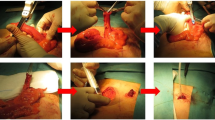Abstract
PURPOSE: Some patients bedridden from various causes such as stroke or spinal cord injury experience poor control of bowel movement. This causes fecal leakage and diarrhea, increases the risk of perianal excoriation and bed sores, and is a burden on caregivers. To evaluate the efficacy of fecal evacuation and the prevention and treatment of skin complications in intractable diarrhea patients using a new device. METHODS: A continent anal plug (US Patent No. 5 569 216) comprises an inner balloon surrounded by an outer balloon, both of which are mounted on a silicone tube containing a pair of air passages and an enema fluid inlet. The tube is secured in place in the rectum by the inflatable outer balloon and is designed to drain fecal matter through a thin collapsible hose situated in the anal canal. Thirty-two patients (21 male; median age 61 (range, 28–76) years) were evaluated after fully informed consent. Median duration was 12 (range, 3–37) days. RESULTS: The continent anal plug evacuated efficiently in those patients with loose or watery stools who only required irrigation once daily or not at all. Skin excoriations improved in three to seven days. Minimal leakage was seen around the anus. There was no anorectal mucosal injury noted over 37 days. CONCLUSIONS: The continent anal plug is an efficient method of treating patients with loss of bowel control and incontinence because it enables controlled fecal evacuation and helps reduce skin complications without causing anorectal mucosal injury.
Similar content being viewed by others
References
Kim J, inventor. Multipurpose colostomy device having balloons an end thereof. US Patent 5 569 216. October 29, 1996.
Lee GY, Kim J, Lim MK, Shim MC. Passive bowel movement with a new colostomy device: an acute experiment in dog. J Korean Soc Coloproctol 1998;14:431–7.
Lim MK, Kim J, Shim MC. Application of a new colostomy device in incontinent dog model. J Korean Soc Coloproctol 1998;14:439–46.
Swash M. New concepts in incontinence. BMJ 1985;290:4–5.
Johanson JF, Irizarry F, Doughty A. Risk factors for fecal incontinence in a nursing home population. J Clin Gastroenterol 1997;24:156–60.
Enck P, Bielefeldt K, Rathmann W, Purrmann J, Tschope D, Erckenbrecht JF. Epidemiology of fecal incontinence in selected patient groups. Int J Colorectal Dis 1991;6:143–6.
Tobin GW, Brocklehurst JC. Faecal incontinence in residential homes for the elderly prevalence, aetiology and management. Age Ageing 1986;15:41–6.
Gabrel CS. An overview of nursing home facilities: data from the 1997 National Nursing Home Survey. Hyattsville, Md: National Center for Health Statistics 2000; Advance data from vital and health statistics; no. 311.
Brocklehurst JC, Andrews K, Richards B, Laycock PJ. Incidence and correlates of incontinence in stroke patients. J Am Geriatr Soc 1985;33:540–2.
Han TR, Kim JH, Kwon BS. Chronic gastrointestinal problems and bowel dysfunction in patients with spinal cord injury. Spinal Cord 1998;36:485–90.
Stone JM, Nino-Murcia M, Wolfe VA, Perkash I. Chronic gastrointestinal problems in spinal cord injury patients: a prospective analysis. Am J Gastroenterol 1990;85:1114–9.
Glickman S, Kamm MA. Bowel dysfunction in spinal-cord-injury patients. Lancet 1996;347:1651–3.
Kim J, Shim M. Clinical application of new colostomy device. Paper presented at: Annual Scientific Meeting of Int Med Soc Paraplegia; June 18–20, 1999; Copenhagen, Denmark.
Pemberton JH, Van Herden JA, Beart RW, Kelly KA, Phillips SF, Taylor BM. A continent ileostomy device. Ann Surg 1983;197:618–26.
Exton-Smith AN. Constipation in geriatrics. In: Jones FA, Goldding GW, eds. Management of constipation. Oxford, England: Blackwell Scientific, 1973: 156–75.
Schuster MM, Hendrix TR, Mendeloff AI. The internal sphincter response. Manometric studies on its normal physiology, normal pathways and alteration in bowel disease. J Clin Invest 1963;42:196–207.
Smith B. Effect of irritant purgatives on the myenteric plexus in man and mouse. Gut 1968;9:139–43.
Molnar T, Taitz LS, Unwin OM, Wales JK. Anorectal manometry results in defecation disorders. Arch Dis Child 1983;58:257–61.
Keighley MR, Williams NS. Surgery of the anus rectum & colon. 2nd ed. London, England: W. B. Saunders, 1999:806–8.
Author information
Authors and Affiliations
Additional information
Poster presentation at the meeting of the American Society of Colon and Rectal Surgeons, Boston, Massachusetts, June 24 to 29, 2000 The study was conducted with a grant from Chun-Ma Medical Research Foundation in 1999.
About this article
Cite this article
Kim, J., Shim, MC., Choi, BY. et al. Clinical application of continent anal plug in bedridden patients with intractable diarrhea. Dis Colon Rectum 44, 1162–1167 (2001). https://doi.org/10.1007/BF02234639
Issue Date:
DOI: https://doi.org/10.1007/BF02234639




